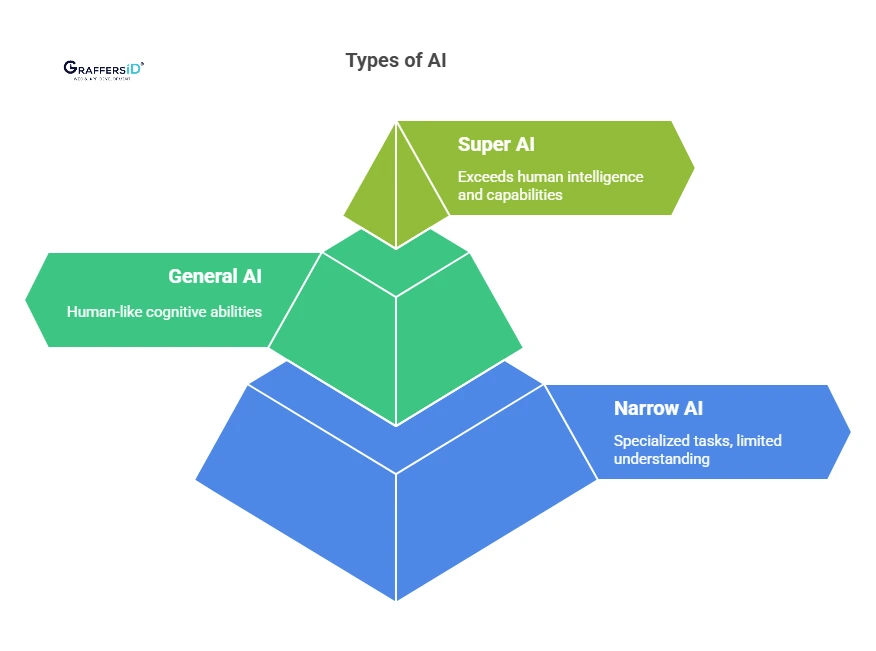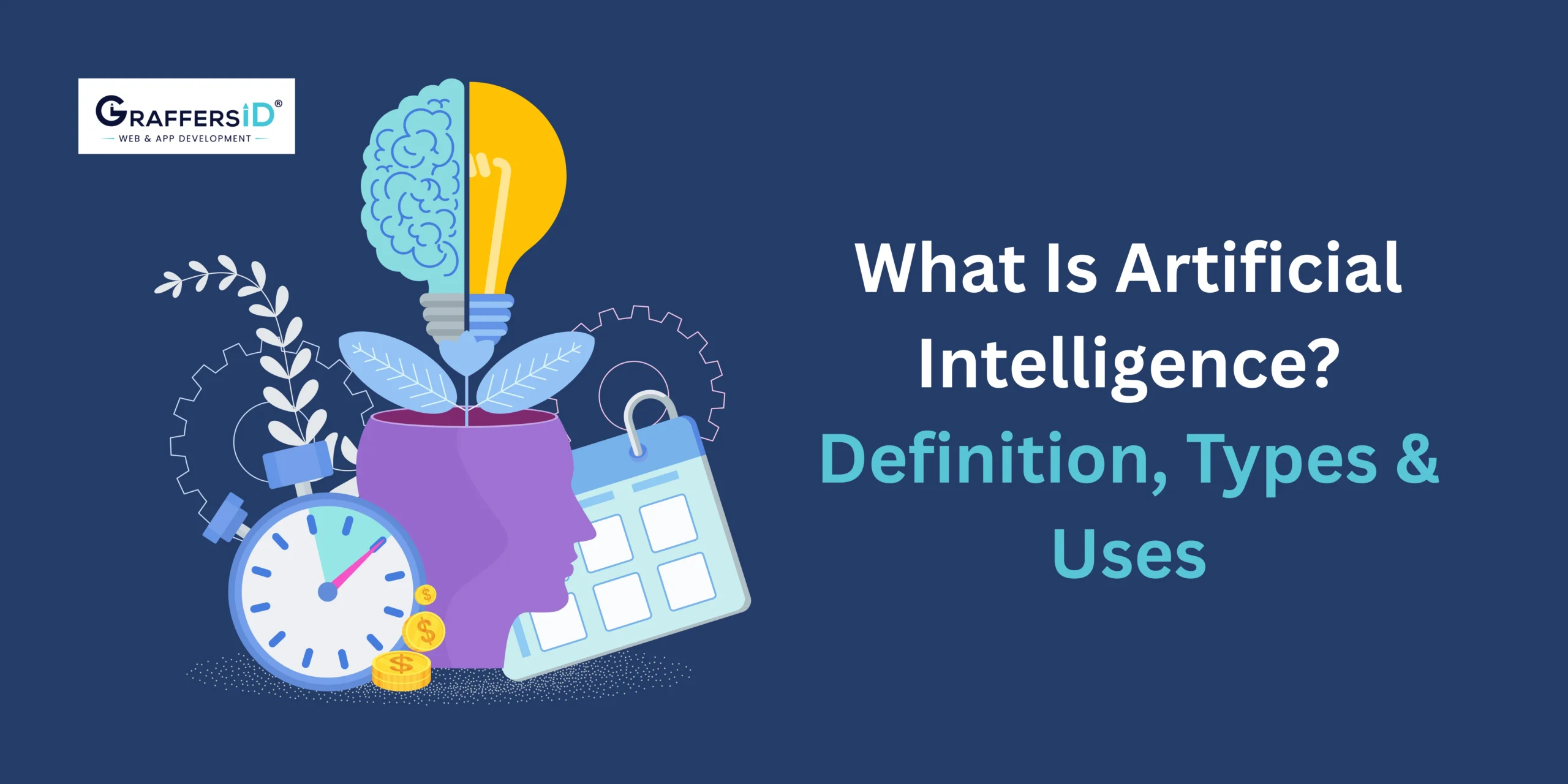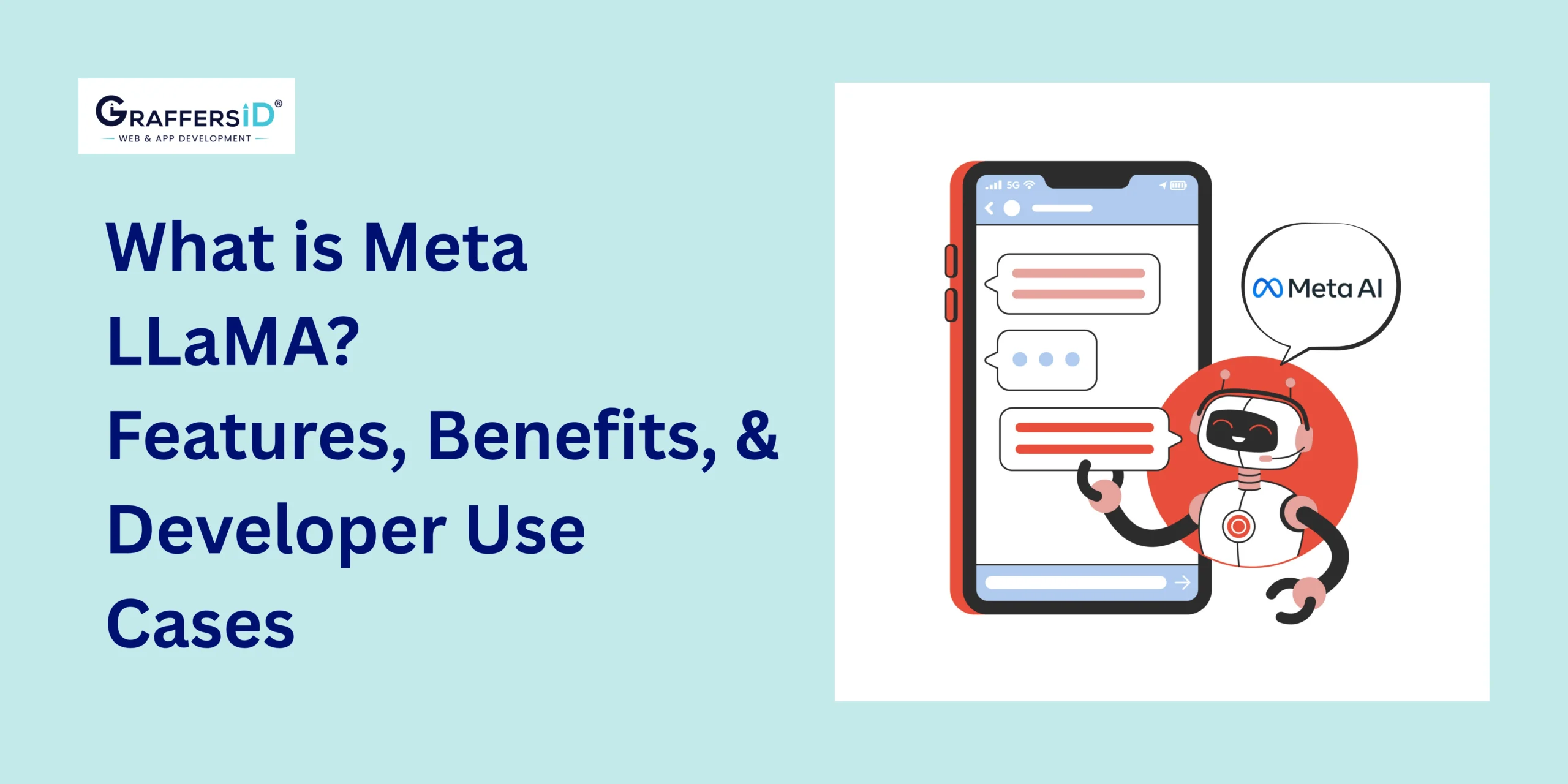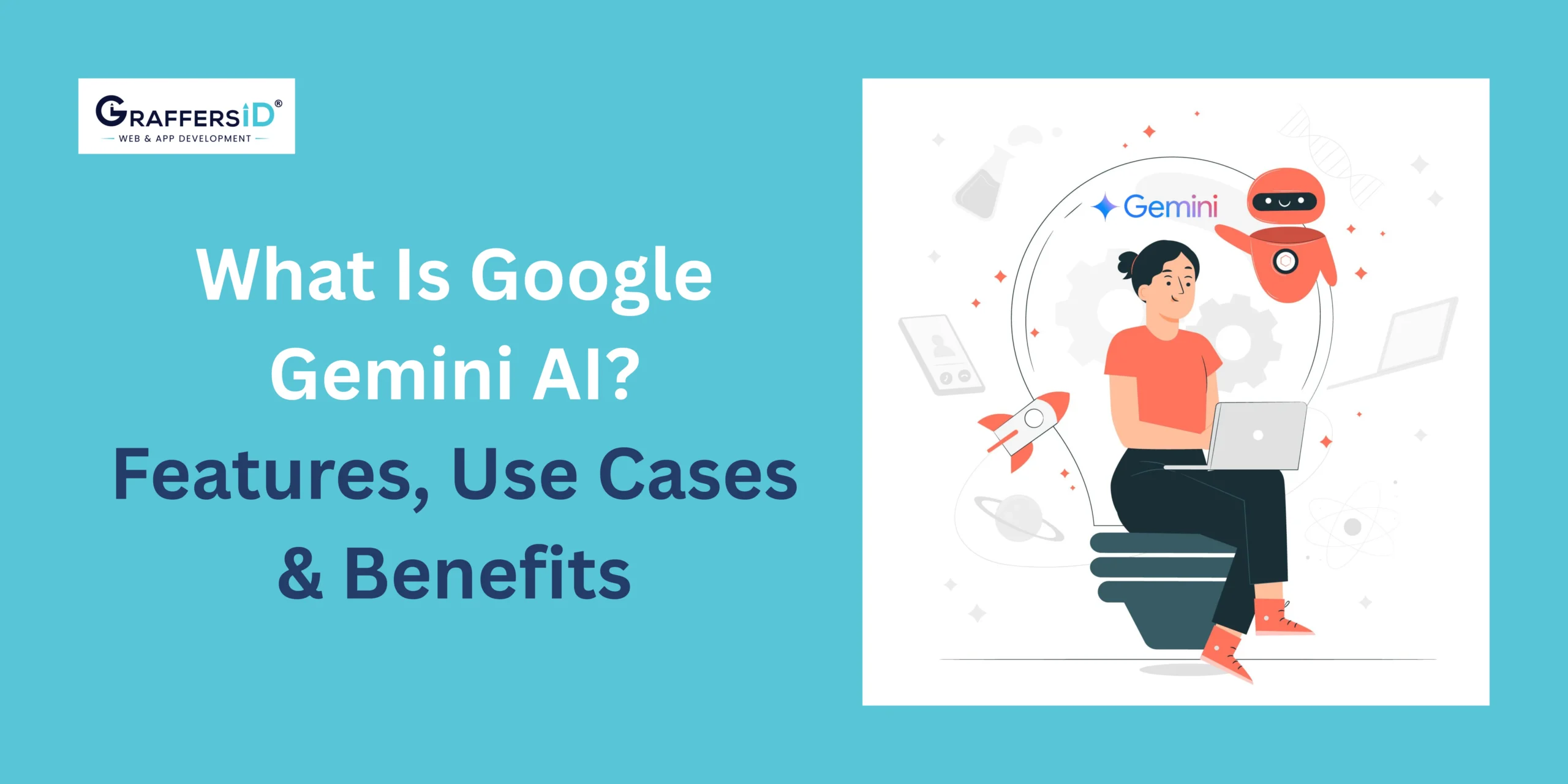Artificial intelligence (AI) is transforming almost all industries, automating tasks, and improving decision-making processes. From smart assistants like Siri and Alexa to self-driving cars and AI-powered analytics, AI has become an essential part of our everyday lives. As businesses continue to expand the boundaries of AI, it is important to understand its concepts.
In this blog, we will look at the evolution of AI, different types of AI, core technologies like Machine Learning and Deep Learning, the benefits of AI, and its real-world applications.
What is Artificial Intelligence?
Artificial intelligence is the replication of human intelligence in machines, allowing them to do activities that require human cognition, such as learning, reasoning, problem-solving, and decision-making. AI systems use algorithms and large databases to enhance their performance and efficiency with time.
Unlike traditional software, which follows predefined guidelines, AI-powered systems can detect patterns, learn from data, and make autonomous decisions, making them more adaptive and efficient.
Read More: ChatGPT vs. DeepSeek vs. Google Gemini: Which AI Model is Best for Developers?
Evolution of AI
AI has evolved greatly since its launch. Let’s discuss how:

- 1950s-1970s: AI emerged as a topic of research, with early experiments in machine learning and problem-solving. Earlier AI research focused on rule-based systems and symbolic reasoning.
- 1980s-1990s: Expert systems, neural networks, and more advanced algorithms were developed. AI saw the rise of machine learning algorithms.
- 2000s-Present: Advancements in deep learning, natural language processing (NLP), and generative AI models. AI applications have spread across various industries, like healthcare, banking, and entertainment.
- Future: The development of Artificial General Intelligence (AGI), in which AI can do every cognitive task that a human can. Researchers are working to make AI more independent and capable of human-like reasoning.
Types of AI
Artificial Intelligence has three types. We will discuss each type of AI in detail, how it works, and its functions.

1. Narrow AI (Weak AI)
Narrow AI, also known as Weak AI, refers to AI systems that are designed and trained for a specific task or a narrow range of tasks. These systems excel in performing predefined functions with a high level of accuracy. Examples of narrow AI are virtual personal assistants like Siri and Alexa, which can understand and respond to specific voice commands, and recommendation systems that suggest products or content based on user preferences.
Narrow AI is designed for specific tasks and cannot generalize beyond them. Examples include:
- Voice assistants: AI-driven tools like Alexa, Siri, and Google Assistant that respond to commands and perform tasks.
- Recommendation systems: AI that suggests products, movies, or music based on user preferences (e.g., Netflix, Amazon, Spotify).
- Chatbots and customer support AI: Automated customer service assistants that handle queries and provide support in real-time.
Limitations of Narrow AI:
-
Lacks true intelligence: It cannot think, reason, or understand emotions like humans.
-
Confined to specific domains: Cannot generalize knowledge to different tasks or areas.
-
Requires extensive training data: Performance depends on the quality and quantity of data used in training.
2. General AI (Strong AI)
General AI is a more advanced form of artificial intelligence that possesses human-like cognitive abilities. Unlike narrow AI, which is confined to specific tasks, general AI is capable of understanding, learning, and applying knowledge across a wide range of tasks. This type of AI has the potential to reason, solve problems, and engage in open-ended conversations. Although it is still theoretical, developments in deep learning and cognitive computing are making progress in that direction. General AI is capable of:
- Understanding and learning any task without being explicitly programmed.
- Exhibiting human-like reasoning and problem-solving abilities.
- Adapting to new challenges across multiple domains.
Limitations of General AI:
-
Complexity of Human Intelligence – Replicating the human brain’s learning process and adaptability is highly challenging.
-
Massive Computational Power – General AI requires immense processing capabilities and data storage.
-
Ethical and Security Concerns – If AI achieves human-like intelligence, ensuring its ethical use and control will be crucial.
3. Super AI
Super AI, also known as Artificial Superintelligence (ASI), will outperform human intelligence in all aspects, including creativity, problem-solving, and decision-making. The concept of ASI raises important ethical questions and considerations about control, safety, and the impact on society. Some of the major issues are:
- Loss of human control over artificial intelligence systems.
- AI-powered decision-making exceeds human intelligence.
- AI autonomy raises ethical concerns.
Core AI Technologies
Artificial Intelligence (AI) is powered by some core technologies that allow machines to learn, process data, and provide insights. Three major AI technologies are:

1. Machine Learning (ML)
Machine Learning is a subset of AI that allows machines to learn from data and improve their performance without requiring additional programming. ML is classified into the following types:
- Supervised Learning: Trains models using labeled data (for example, spam detection and image recognition). The AI learns patterns from input-output pairs.
- Unsupervised Learning: Detects patterns in unlabeled data (for example, customer segmentation, anomaly detection). The AI identifies hidden structures in data.
- Reinforcement Learning: AI learns by interacting with its surroundings and getting input (for example, self-driving cars and AlphaGo). The AI optimizes activities based on benefits and penalties.
2. Deep Learning
Deep Learning is a subset of machine learning that processes complex patterns using artificial neural networks. These neural networks simulate the human brain’s structure, allowing AI models to learn from large amounts of unstructured data, such as images, audio, and text.
Applications of Deep Learning:
1. Image and Speech Recognition
-
Face recognition: AI models used in security systems and social media platforms (e.g., Apple’s Face ID, Facebook’s photo tagging).
-
Speech-to-text systems: AI-powered assistants like Siri and Google Assistant convert speech into text.
2. Autonomous Vehicles: AI-driven self-driving cars process visual data from cameras, detect objects, and make real-time driving decisions.
3. Healthcare Diagnostics: AI models analyze X-rays and MRI scans to detect diseases like cancer and pneumonia.
3. Generative AI
Generative AI models create new content, including text, images, music, and videos, by learning from existing data. These models use advanced deep learning techniques such as Generative Adversarial Networks (GANs) and Transformers to generate realistic content.
Applications of Generative AI:
1. Text Generation: Assists incontent creation, article writing, and summarization.
2. Image and Video Generation: Creates realistic images and videos from text descriptions.
3. Music and Voice Generation: Generates human-like synthetic voices like famous artists.
Benefits of AI

1. Automation of Repetitive Tasks
AI automates repetitive and time-consuming tasks, allowing businesses to improve productivity and efficiency. By handling daily tasks, AI allows human workers to focus on more complex and strategic activities.
-
In customer support, AI chatbots handle FAQs, order tracking, and support requests.
-
In data entry and processing, AI automates invoice processing, document verification, and record-keeping.
-
In manufacturing, AI-driven robots assemble products, reducing manual labor and increasing production speed.
Example: AI automation tools like UiPath and Blue Prism help businesses enhance workflows by automating repetitive tasks.
2. Smart and Faster Data Insights
AI processes large amounts of data quickly, identifying patterns and trends that humans might overlook. This helps businesses make data-driven decisions more efficiently.
-
AI business intelligence tools analyze sales trends, customer behavior, and market changes.
-
AI in healthcare analyzes patient data to detect diseases early and recommend treatments.
-
AI in finance analyzes stock market trends and predicts investment opportunities.
Example: Google Analytics and Tableau use AI to generate real-time insights for businesses, helping them improve performance.
3. Enhanced Decision-Making
AI improves decision-making by providing accurate, data-driven recommendations. Machine learning models analyze historical and real-time data to help make informed choices.
-
In finance, AI helps banks assess loan applications by analyzing credit histories.
-
In supply chain management, AI predicts demand fluctuations and optimizes inventory.
-
In marketing, AI customizes ad campaigns by targeting the right audience based on behavioral data.
Example: Amazon uses AI-driven recommendation systems to suggest products based on user preferences, increasing sales.
4. Reduced Human Errors
AI reduces human errors by performing tasks with high accuracy and consistency. Unlike humans, AI does not feel tired or face distractions, which thereby improves accuracy.
-
In medicine, AI diagnostic tools reduce misdiagnosis rates.
-
In accounting, AI automates calculations and prevents financial inconsistencies.
-
In cybersecurity, AI detects threats and prevents data breaches by identifying unusual activities.
Example: AI software like Grammarly helps writers by automatically detecting and correcting grammatical errors.
5. 24×7 Availability
Unlike humans, AI systems can work continuously without needing breaks, making them suitable for customer service, monitoring, and automation.
-
AI chatbots provide real-time support to customers across different time zones.
-
AI monitoring systems track security issues and system performance 24/7.
-
AI-driven automation keeps production lines running smoothly, reducing downtime.
Example: AI-powered virtual assistants like Siri and Alexa are available all the time to help users with tasks such as setting reminders, answering questions, and controlling smart devices.
Read More: Role of Artificial Intelligence in Software Development in 2025
AI Use Cases Across Industries
The following is a detailed explanation of how AI is used across different industries:

1. AI in Healthcare
AI is reshaping the healthcare industry by enhancing diagnosis, treatment planning, and patient care.
AI-Powered Diagnostics
AI programs analyze medical images such as X-rays, MRIs, and CT scans to detect cancer, fractures, and infections. AI models trained on large datasets can identify abnormalities with great accuracy, sometimes outperforming human radiologists.
For example, Google’s DeepMind created an AI model that can identify more than 50 eye conditions based on retinal scans.
Drug Discovery and Personalized Treatment
AI speeds up drug research by analyzing complex biological data to find possible drug candidates. It also helps in personalizing treatments depending on an individual’s genetic composition, hence improving therapy effectiveness.
For example, IBM Watson uses AI to provide personalized cancer treatments based on a patient’s medical history and genetic profile.
AI Chatbots for Mental Health Support
AI-powered chatbots and virtual therapists help people with mental health issues by engaging them in conversations, providing coping skills, and identifying signs of mental illness. These AI-powered solutions make therapy easier and affordable.
Woebot and Wysa, for example, are AI chatbots that promote mental health through cognitive-behavioral therapy (CBT).
2. AI in Finance
Financial organizations use AI for various banking offerings, such as:
Fraud Detection and Risk Assessment
AI monitors financial transactions in real time to detect unusual activities like identity theft and money laundering. Machine learning models analyze spending patterns and identify unusual events that may indicate fraud.
For instance, PayPal and Mastercard use AI to detect fraudulent transactions and prevent illegal access.
AI-Powered Investment Strategies and Trading
AI-powered trading systems analyze market trends, historical data, and real-time financial information to make investment decisions. These systems can execute high-frequency trades much quicker than human dealers.
For example, hedge funds like Renaissance Technologies use AI to optimize investing strategies and maximize returns.
Personalized Financial Planning
AI-powered financial advisors evaluate users’ income, expenses, and financial goals to make personalized investment and savings advice.
For example, robo-advisors such as Betterment and Wealthfront provide automated portfolio management based on AI analysis.
3. AI in E-Commerce
AI in e-commerce improves the online shopping experience by offering customized suggestions, automating customer service, and managing inventory. These can be studied in detail below:
Personalized Shopping Suggestion Engines
AI analyzes customer behavior, purchase history, and preferences to suggest items that are tailored to each unique user, increasing sales and engagement.
For example, Amazon and Flipkart use AI to recommend products based on browsing history and previous purchases.
AI Chatbots for Customer Engagement
AI-powered chatbots respond to consumer inquiries, process orders, and resolve issues in real time, ensuring a smooth shopping experience.
Chatbots, such as Shopify’s Kit and Drift, help clients by answering questions and offering product recommendations.
Automated Inventory Management
AI analyzes sales patterns, seasonal trends, and supply chain data to forecast demand changes and optimize inventory levels.
For example, Walmart uses AI to forecast demand promptly and restock products, removing overstocking and stockout issues.
4. AI in Manufacturing
AI-driven automation boosts efficiency, reduces downtime, and maintains product quality in manufacturing.
Predictive Maintenance for Machinery
AI analyzes machinery performance through sensors and predicts when machinery is likely to break down, allowing for timely maintenance and decreasing unexpected downtime.
For example, General Electric uses AI-powered predictive maintenance to increase operational efficiency at factories.
AI-Driven Quality Control
Computer vision and machine learning algorithms scan products on assembly lines to identify defects and ensure high-quality standards.
For example, Tesla uses AI-powered cameras to identify any issues in car parts during the production process.
Robotics in Assembly Lines
Complex assembly tasks are accurately completed by AI-powered robots, speeding up production and reducing the cost of human labor.
For example, BMW and Ford use AI-powered robots for their assembling tasks.
5. AI in Software/Web Development
AI is transforming the web and software development industry by automating coding, enhancing cybersecurity, and optimizing user experience.
AI-Assisted Software Development
AI-powered tools assist developers by generating code, suggesting optimizations, and automating debugging. AI can analyze existing codebases and predict the best ways to optimize performance and reduce bugs.
Example: GitHub Copilot and Tabnine use AI to suggest code snippets and autocomplete functions for developers.
AI for Cybersecurity and Threat Detection
AI-powered security systems analyze network traffic and detect potential cyber threats, such as malware, phishing, and DDoS attacks, in real-time. AI-driven anomaly detection helps identify vulnerabilities before they are exploited.
Example: Darktrace and CrowdStrike use AI to detect and neutralize cyber threats before they cause damage.
Automated Testing and Bug Fixing
AI-powered testing tools automate software testing, reducing manual efforts and speeding up the development cycle. AI can identify errors, predict potential bugs, and suggest fixes, improving software reliability.
Example: AI-driven testing platforms like Testim and Applitools automate UI and functional testing in software development.
Conclusion
Hence in this way, artificial intelligence becomes a necessary part of today’s technology, which helps in solving many problems of almost all industries with automation, insights, and enhanced decision-making. However, factors like bias and ethics must be addressed properly. As AI continues to grow, businesses and decision-makers must ensure its ethical and fair development to increase its benefits for society.
Our skilled developers at GraffersID are experts in advanced AI technologies, helping businesses build powerful and scalable AI-driven applications. If you’re looking to develop an AI-powered solution, partner with GraffersID to hire the best developers and speed up your innovation.





